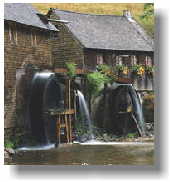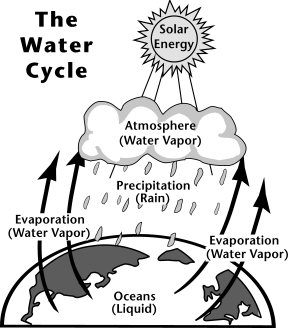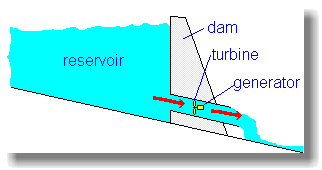 .............
.............
We have used running water as an energy source for thousands of years, mainly to grind corn. This is an old watermill, where the water ran round a paddle wheel, turning it, to make power to grind grains into flour.
 .............
.............
Understanding the water cycle is important to understanding hydropower. In the water cycle -
Mechanical energy is derived by directing, harnessing, or channeling moving water. The amount of available energy in moving water is determined by its flow or fall. That means a fast flowing river where the water is rushing downhill quickly is better for generating power than a slow moving river where the water doesn't have much fall. Places like New Zealand use a lot of hydro-electric power stations, because we have lots of mountains and rivers, and high rainfall.
 ..................
.................. 
A dam is built to trap water, usually in a valley where there is an existing lake. Water is allowed to flow through tunnels in the dam, to turn turbines and thus drive generators.
Notice that the dam is much thicker at the bottom than at the top, because the pressure of the water increases with depth. Hydro-electric power stations can produce a great deal of power very cheaply.
Gravitational potential energy is stored in the water above the dam. Because of the great height of the water, it will arrive at the turbines at high pressure, which means that we can extract a great deal of energy from it. The water then flows away downriver as normal.
In mountainous countries such as Switzerland and New Zealand, hydro-electric power provides more than half of the country's energy needs.
ADVANTAGES
Once the dam is built, the energy is virtually free, and no waste or pollution is produced. It is much more reliable than wind, solar or wave power. Water can be stored above the dam ready to cope with peaks in demand.
Hydro-electric power stations can increase to full power very quickly, unlike other power stations, and electricity can be generated constantly.
It is renewable, because the sun provides the water by evaporation from the sea, and will keep on doing so.
DISADVANTAGES
The dams are very expensive to build. However, many dams are also used for flood control or irrigation, so building costs can be shared. Building a large dam will flood a very large area upstream, causing problems for animals that used to live there. In China at the moment, they are finishing the world's largest dam, and people are very worried about the effect it will have on the environment. They even think the weight of the water in the huge lake formed behind the dam may cause earthquakes.
Finding a suitable site can be difficult - the impact on residents and the environment may be unacceptable. Water quality and quantity downstream can be affected, which can have an impact on plant life. Fish which swim up rivers to spawn can't swim up a dam.
Another problem we regularly face in New Zealand is when we have a drought, and there is less rainfall than usual. Then the storage lakes do not hold enough water for us to use for drinking, or for power generation.